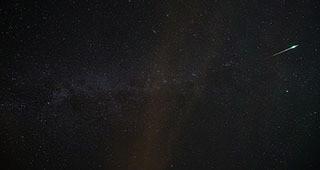Have you ever seen a “shooting” or “falling” star? These streaks of light are not actually stars at all, but space rocks falling through the earth’s atmosphere. These rocks, called meteoroids or meteors, rub against particle’s in the earth’s atmosphere as they fall. This creates friction, making the meteor extremely hot. Usually, the meteors become so hot they burn up and disappear before hitting the earth. The flame of that burning up is what we see and what makes meteors look like a star falling out of the sky. A meteor that survives its journey through the atmosphere and lands on the earth, is a meteorite.
At certain times of year we can see a lot of meteors all at once because the earth is passing through a field of space rocks. These times of year are called “meteor showers” because so many space rocks are falling through the earth’s atmosphere at one time. Each year in late summer the Earth passes through a trail of dust and debris left by an ancient comet called Comet Swift-Tuttle. This creates a lot of meteors that look like they are coming from the constellation Perseus. That’s we we call this time of year the Perseid Meteor Shower.
In 2025 the Perseid Meteor Shower will occur from July 17to August 24, and be at its peak around August 12.
The best way to see meteors is to go outside after dark when meteor showers are predicted, like the Perseid Meteor Shower. Lie on your back and look straight up. You might have to wait. Bring a good snack like popcorn!
This meteorite is an Artifact at The Children’s Museum of Indianapolis. “Meteorites are one of the few extraterrestrial, from outer space, materials scientists have to study. Most meteorites found on the ground are iron, which are very dense and appear quite different from ordinary rock. This is a Gibeon meteorite made up mostly of iron and nickel.”
Websites, Activities & Printables:
- NASA Space Place: Meteor Shower!
- NASA: Meteors & Meteorites Overview
- NASA Astronomy Picture of the Day: Perseid Meteors over Mount Shasta
- American Meteor Society: Meteor Shower Calendar
- European Space Agency for Kids: Meteors & Comets

You can also ask a math and science expert for homework help by calling the Ask Rose Homework Hotline. They provide FREE math and science homework help to Indiana students in grades 6-12.
Meteor Showers in Books
Use your indyPL Library Card to check out books about meteors at any of our locations, or check out meteor e-books and audiobooks from OverDrive Kids right to your device! If you have never used OverDrive before, you can learn how to use it for both e-books and audiobooks.
Need more help? Ask a Library staff member at any of our locations or call, text or email Ask-a-Librarian. Additionally, the Tinker Station helpline at (317) 275-4500 is also available. It is staffed by device experts who can answer questions about how to read, watch and listen on a PC, tablet or phone.






